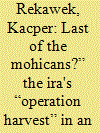| Srl | Item |
| 1 |
ID:
148910


|
|
|
|
|
| Summary/Abstract |
In 1956, the Irish Republican Army (IRA) launched “Operation Harvest,” an overtly ambitious guerrilla effort that was meant to secure the political unity of Ireland by force of arms. It was waged against the backdrop of a “thaw” in international relations and drew inspiration from successful anti-colonial guerrilla struggles in Algeria and Cyprus. The IRA was unaware of the simultaneous, parallel, unsuccessful irredentist efforts in Central and Eastern Europe in which anti-communist guerrillas clashed with totalitarian security apparatuses of the USSR or its satellite states. Studying the latter campaigns, which had begun earlier and were conducted by far larger and more effective guerrilla forces, might have convinced the organisation that such insurgencies in post-1945 Europe had very little hope of success. This article for the first time thematically contrasts the irredentist efforts of the IRA and the parallel Central and Eastern European guerrillas. It aims to bring to light cases that are hardly ever discussed in the Irish context but which could be of surprising use if one wishes to comparatively assess Ireland or the IRA.
|
|
|
|
|
|
|
|
|
|
|
|
|
|
|
|
| 2 |
ID:
125104


|
|
|
|
|
| Publication |
2013.
|
| Summary/Abstract |
The Provisional Irish Republican Army (PIRA), one of the best known and most researched terrorist organizations in history, has been comparatively assessed alongside various terrorist outfits from around the world. However, it has never been systematically compared with its most immediate rival, neighbour, and competitor, the lesser known Official Irish Republican Army (OIRA). This article addresses this scholarly gap and presents a thematic assessment of the similarities and differences between the two organisations in their respective post-ceasefire periods of 1972 and 1994. It proposes a new comparative approach to studying terrorist organisations in which knowledge about a better known entity (here, the PIRA) and its future trajectory is generated through a detailed assessment of the activities and developments of a not only more obscure case (here, the OIRA) but also, in many aspects, the most comparable case or cases. Such an approach could yield interesting results for the field of terrorism studies, which could still profit from in-depth, internal, case study analyses of specific terrorist organizations.
|
|
|
|
|
|
|
|
|
|
|
|
|
|
|
|